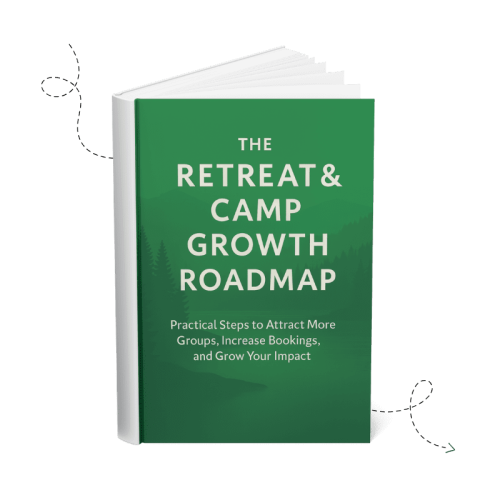Retreat & Camp Growth Roadmap Focus Area: Develop Blog Content
Introduction
Blog content often gets pushed to the margins. It feels like something you’ll get to “when things slow down.” But in reality, consistent blogging is one of the most versatile tools you can use to grow your retreat center or camp. Blog articles don’t just attract new visitors from search engines—they build trust with planners, answer questions before they’re asked, and equip your team with resources to use in conversations.
Done well, blogging becomes more than marketing. It’s a form of ministry: stewarding your knowledge and experience to serve groups well at every step of their retreat journey. And as a director, you don’t have to write the posts yourself—your role is creating the space and process that ensures the right stories get shared.
Why This Focus Area Matters
Executive directors and program leaders share a common challenge: planners want confidence that their retreat will go smoothly, but they often come with the same questions. Blog content positions your retreat center as a guide, not just a provider of space.
It matters because it makes your website more discoverable in search results, strengthening SEO for retreat centers and Christian camp marketing. It also engages and informs visitors who are considering your venue, giving them clarity on next steps. Just as importantly, it supports your mission by equipping people to plan life-changing retreats with less stress and more confidence.
In short, blogging combines marketing, service, and ministry into one powerful tool.
Is This an Area You Need to Focus on Right Now?
Here are a few reflection questions to help you decide:
- Do we have blog posts that answer the most common questions group leaders ask?
- Are our blog articles helping our staff and sales team handle inquiries more smoothly?
- Do we have content that speaks to multiple audiences, not just retreat planners?
- Are we posting consistently, or only when someone has extra time?
- Are our articles optimized so people can actually find them in search?
If you answered “no” to any of these, this focus area can help you bring greater clarity, alignment, and impact to your outreach.
Putting This Focus Area into Practice
How Blogs Work for You
Blog content serves several purposes at once. First, it attracts organic search traffic by giving your website a steady flow of fresh, relevant material that Google values. When paired with optimized group pages, blogs help you stay visible when planners are actively searching for retreat options.
Second, blogs engage and equip planners. Articles about budgeting, packing lists, or sample schedules show you understand their real challenges. That builds trust long before they pick up the phone.
Finally, blog posts make life easier for your sales team. Instead of re-explaining the same answers repeatedly, staff can send a helpful article link. That simple step positions your center as a trusted partner rather than just a vendor.
How to Do It Well
When blogging works, it’s usually because of a few key practices. Posting consistently—even once a month—goes a long way. Writing with your target audience in mind ensures the content is actually useful, while search optimization helps those readers find it. Every blog should also include a clear call to action, such as downloading a retreat planning guide, scheduling a call, or reading related content. Think of it this way: a blog without a CTA is like a retreat without a closing session—it misses the moment to guide someone toward their next step. Internal links to related pages, such as facilities or pricing, also make it easy for readers to continue exploring your site.
Mixing evergreen topics (timeless, always-relevant posts) with seasonal ones (like summer camps or fall retreats) keeps your content library both fresh and dependable.
On the other hand, there are some common pitfalls worth avoiding. Writing about random topics that don’t serve your audience is a waste of time. Publishing shallow, very short posts rarely builds trust. Neglecting SEO basics like titles, keywords, and structure means the content won’t be found. Forgetting to answer the actual questions your audience cares about leaves them frustrated. And skipping calls to action or internal links means readers are left at a dead end.
The difference between a blog that generates impact and one that gathers dust usually comes down to these best practices and pitfalls.

Where to Find Ideas
The good news is that blog topics aren’t hard to come by once you know where to look. Think about the retreat journey: planners face decisions about venue selection, budgeting, scheduling, and follow-up. Each stage of that process is an opportunity to provide clarity and guidance. For example, you could write about what to look for in a retreat center, share a budgeting guide, or offer tips on evaluating the success of a retreat.
But don’t stop with planners. Donors may value impact stories that show their contributions at work. Volunteers might enjoy behind-the-scenes spotlights. Staff could share reflections that foster a sense of connection. Even your local community might appreciate updates on events or service projects.
When you broaden your view, you’ll find countless retreat marketing ideas that not only attract planners but also nurture every relationship tied to your ministry.

How to Resource It
One of the most common concerns is, “Who’s going to write all this?” The answer: it doesn’t have to all fall on you.
Start small—one quality blog per month is enough to build momentum. Involve others where you can: interns, volunteers, staff, or even past guests may be glad to contribute. Repurpose existing materials such as FAQs, retreat evaluations, or training notes into articles. If your team is stretched thin, consider bringing in a camp marketing agency. They can provide capacity while still keeping the voice authentic.
With the right approach, blog writing becomes a manageable and sustainable effort.
What About AI? Navigating a Changing Landscape
At this point you may be asking, “But what about AI? Can’t it just write the blogs for us? And if AI overviews on Google or ChatGPT reduce traffic, is blogging even worth it anymore?”
Here’s the balanced view:
AI can be a helpful assistant in content creation. Tools like ChatGPT are great for brainstorming ideas, building outlines, or drafting a first pass. But they lack your unique story, mission, and authenticity. Human oversight is non-negotiable if you want content that resonates and builds trust.
It’s also true that AI-driven search experiences may reduce visible traffic or make attribution harder. Yet the content on your website still strengthens your authority, supports your SEO, and provides valuable resources your staff can share directly with planners.
Think of AI as changing the landscape, not eliminating the value of blogging. Retreat centers that continue publishing authentic, helpful content will stand out both online and in conversations.
Blog Content Planning Worksheet
Creating great blog content starts with asking the right questions. Instead of trying to guess what to write or forcing yourself to churn out random topics, this worksheet is designed to help you uncover ideas that are both strategic and sustainable. By walking through its questions, you’ll generate a long list of blog topics that not only attract the right prospects but also support your sales process and nurture long-term relationships with planners, donors, staff, and community members.
📥 Download the Blog Content Planning Worksheet
This tool makes blog planning less about staring at a blank page and more about connecting your mission, your audience’s needs, and your marketing goals. With it, you’ll have a clear framework for developing content that engages, equips, and inspires.
Mini Case Study
When we first partnered with a Christian retreat center in PA, their blog was active but limited. Posts came out sporadically and leaned heavily on personal staff reflections. While meaningful to existing guests, the content wasn’t serving broader sales or marketing goals.
We worked together to create a strategy that made blogging both consistent and purposeful. Articles were published at varying rhythms—sometimes weekly, sometimes monthly—but always aligned with three goals: boosting search visibility, equipping the sales process, and strengthening customer relationships. The work was shared between agency writers and internal staff, often collaborating on ideas, outlines, editing, and publishing.
Today, their blog is one of their most powerful marketing tools. It attracts thousands of visitors each week, fuels organic search growth, and provides content their sales team regularly references to answer questions. Beyond that, the blog supports their social media presence and is featured in monthly newsletters, keeping past guests engaged and connected.
Putting It All Together
Blog content is not about filling space on a website. It’s about attracting and engaging new groups through search visibility, equipping retreat planners with practical resources, and giving your sales team ready-to-use answers. It’s also about avoiding common pitfalls, building consistency, and exploring a wide range of content ideas that serve multiple audiences.
By leveraging resources you already have—people, stories, and insights—you can build a blog program that not only grows your reach but also deepens your ministry impact.
Here are a few practical action steps to help you get started:
- Set a realistic rhythm. Commit to publishing one quality post each month to start.
- Brainstorm topics with your team. Use the Blog Content Planning Worksheet to gather ideas from staff, sales, and program leaders.
- Write with purpose. Make sure each article serves at least one goal: attract new visitors, support the sales process, or nurture existing relationships.
- Optimize for visibility. Apply SEO basics (titles, keywords, internal links) so your blogs can be found in search.
- Always include a next step. Add calls to action—downloads, contact forms, or links to related content—to keep readers moving forward.
- Measure and adjust. Track which posts drive engagement or get referenced in sales conversations, and use those insights to guide future content.
When blogging is approached this way, it becomes one of the most cost-effective and mission-aligned retreat marketing strategies you can use.
Ready to Take the Next Step?
Blog content can feel intimidating, but it doesn’t have to. Start with what you know, lean on your team and resources, and take small, consistent steps. Over time, you’ll build a library of content that attracts, equips, and inspires.
If you found this helpful, here are four great next steps to continue your journey:
🧭 Move to the Next Focus Area: Execute On-site SEO
Learn how to improve your website’s visibility by running regular SEO audits and updates, ensuring your content stays optimized and easy to find.
[Read Execute On-site SEO Article]
📘 Download the Retreat & Camp Growth Roadmap eBook
Get the full 3-stage system we use to help retreat centers and camps grow with clarity and purpose.
[Download the eBook]
🌱 Learn More About How We Help Retreat Centers & Camps
We’re a Christian-owned digital marketing agency that helps retreat centers and camps grow attendance, bookings, and impact through practical strategies rooted in clarity and stewardship.
[See How We Can Help]
🤝 Schedule a Free Discovery Call
Want help applying this to your unique situation? Let’s talk. We’ll explore where you are now, where you want to go, and how to take the next faithful step.
[Book a Discovery Call]
You don’t have to figure this out alone. Let’s build something meaningful—together.
Frequently Asked Questions
1. How often should we post new blogs?
For most retreat centers, one well-written post per month is a sustainable and effective pace. Consistency matters more than volume.
2. How long should a blog article be?
Aim for 800–1200 words. This length allows enough depth to be helpful, while also aligning with SEO for retreat centers.
3. What if we run out of ideas?
Start with FAQs from planners, common objections, or seasonal topics. Repurpose staff notes, retreat evaluations, or even volunteer spotlights.
4. How do blog posts connect with SEO for camps and retreat centers?
Every blog post adds new keywords, increases your site’s relevance, and improves rankings for topics planners are actively searching.
5. Should blog posts include calls to action?
Yes. Each blog should invite readers to take a next step—whether downloading a guide, exploring facilities, or contacting your team. Blogs without CTAs tend to be read and forgotten, rather than driving deeper engagement.
6. What are the biggest pitfalls to avoid?
Common pitfalls include writing on random topics, producing shallow content, forgetting to optimize for search, ignoring audience needs, or leaving out calls to action and internal links.
7. Can AI tools write blog posts for us?
AI can draft or inspire, but it should never replace your voice. Human review ensures accuracy, authenticity, and alignment with your mission.
8. If AI search results reduce website traffic, is blogging still worth it?
Absolutely. Blog content still strengthens your site’s authority, supports your SEO, and provides resources for your team to share directly with planners and guests.
9. Should we outsource blog writing?
If you don’t have the time or capacity internally, outsourcing to a freelancer or retreat marketing agency can be a smart investment. The key is keeping your mission and voice central.
10. How do we measure success from blogs?
Look beyond just page views. Success might mean inquiries that reference your content, sales calls that run smoother, or a stronger presence in local search results.





